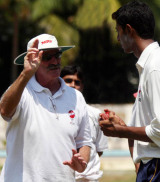MRF academy offers to help BCCI train fast bowlers
The BCCI is dithering over an offer from the MRF Pace Foundation in Chennai to make available their facilities to help in the rehabilitation process of out-of-form bowlers
Anand Vasu
19-Nov-2007
|
|

|
The Board of Control for Cricket in India is dithering over an offer from the MRF Pace Foundation in Chennai, headed by Dennis Lilllee and run by TA Sekar, to make available their facilities to help in the rehabilitation process of out-of-form bowlers and in grooming promising fast bowlers from age-group and Ranji Trophy cricket.
The latest offer was made soon after Ravi Shastri became director of the National Cricket Academy, which was followed by the appointment of Dav Whatmore to head the training academy in Bangalore. According to the proposal, between 30 and 35 promising young fast bowlers can undergo training at the Pace Foundation for a minimum of eight weeks in a year.
This is not the first time the Pace Foundation has made such an offer, but the BCCI has been reluctant to enter into any formal agreement in the past. Initially the BCCI was wary to use the facilities of a private organisation, but in the recent past they have not been shy to do so, whether it is employing consultants to look at soil conditions to improve pitches or bring in experts in other capacities. However this is not the first time the Pace Foundation ahs offered its services to the board. Why the BCCI has not utilised this facility all this while is a moot question. Will the BCCI finally come around and work with this organisation? That is the question.
"If we have to work together then some kind of Memorandum of Understanding has to be signed first," said a BCCI official. "There is a proposal with the NCA committee, which is looking into the matter, but nothing has been decided as yet."
Whatmore has already conveyed to the BCCI that the NCA would focus on dealing with cricketers who are on the verge of making it to the big league, or have just lost their places in the team, while those from younger age groups, the under-17s, the under-19s and under-21s, would be the responsibility of respective state associations. It is this age group that the Pace Foundation has offered to focus on.
The Pace Foundation operates actively from April 15 to September 15 each year, with Lillee, widely regarded as the best fast-bowling coach in the game, spending two fortnights in India each year. The Pace Foundation gets regular visits from cricketers and coaches from around the world. Troy Cooley, who worked successfully with England's fast bowlers ahead of the 2005 Ashes and is now with Australia, is a regular visitor at the Pace Foundation, and has acknowledged the contribution that interactions with Lillee have made.
Apart from this, the English, Australian, Sri Lankan, Bangladeshi and Pakistani boards routinely send their wards to train at the Pace Foundation. So far, however, the BCCI has resisted entering into any kind of formal agreement with the foundation, which will complete its 20th year of operation in January this year.
India's struggle for pace bowlers, or even medium-pace bowlers who swing or seam the ball consistently in a variety of conditions, continues, and as the ODIs give way to Test cricket this aspect has come into sharp focus. The tall young hopefuls like VRV Singh and Pankaj Singh have shown flashes of promise, but have not come through. Ishant Sharma, who was literally pitchforked into the national spotlight, has returned to Delhi with plenty of work to do.
While Zaheer Khan, Sreesanth and RP Singh have cemented their places, there's no obvious reserve to make up the bench. However, India are likely to pick at least a couple of more medium-pace bowlers, as Dilip Vengsarkar, the chairman of the selection committee, had said before India went to England for their last Test series that five quick bowlers was the ideal number. India played three Tests in England, and in Australia they are playing four, which means a heavier workload for the fast bowlers. If they do not go with VRV or Ishant, the selectors may have to turn the clock back to Munaf Patel, who continues to struggle with form and fitness, or Ajit Agarkar, who has been discarded and recalled more times than one can remember, or plump for rank outsiders like Ranadeb Bose or Shib Sankar Paul.
Anand Vasu is an associate editor at Cricinfo.